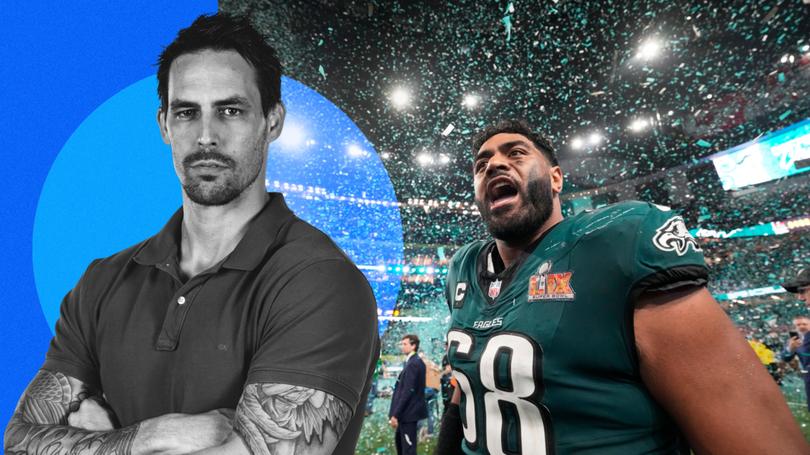MITCHELL JOHNSON: NFL Super Bowl shows that slow-paced games can run at lightning speed

Watching the Super Bowl got me thinking about a few things.
Is it the biggest, most-watched event in the world? The numbers show it is right up there, with 115.1 million fans tuning in but it is outdone by the UEFA Champions League final as after all soccer is the global game.
Monday’s spectacle - which saw Australia’s first Super Bowl champion crowned in Jordan Mailata - got me thinking about why the NFL and the Super Bowl in particular, is just so popular.
Sign up to The Nightly's newsletters.
Get the first look at the digital newspaper, curated daily stories and breaking headlines delivered to your inbox.
By continuing you agree to our Terms and Privacy Policy.The amount of money that is thrown around for entertainment is insane.
The biggest acts around the world — like Kendrick Lamar this week — want that chance to be part of a significant event, knowing that hundreds of millions of people will be watching.
Then brands are falling over themselves and through massive amounts just to get a 30-second slot. Those ads can cost around $7 million and with a few spots to fill throughout a game, the advertisements alone will be raking in around a billion dollars.
But I want to look into why the Super Bowl is so big and exciting as an outsider with an open mind.
I enjoy most sports and don’t mind the NFL. It’s interesting that in today’s world, a slow-paced sport is so popular when fans are often looking for quick games or events, as it seems we’re all time-poor or want that quick fix.
This game, with stoppages after just seconds of play, timeouts and long breaks for officiating, has endured.
The action on the field can be fast and exciting and I appreciate the plays that the teams come up with.
I’ve seen documentaries and watched YouTube videos on the athleticism and training regimes that the best players go through — and it’s impressive.
The contact aspect has been a topic of discussion over the years, especially regarding head injuries, but aside from that, the game itself is enjoyable to watch.
The funny thing about it is that all the stoppages and time in between can feel like watching grass grow.
I played Test cricket and would get similar comments from random people all the time, but I never cared too much.
I’m sure if I watched those people at their day jobs, I’d find it equally slow and boring.
It’s all about finding our own niche and excelling in it while continuing to enhance the spectator experience.
Each to their own, but I’m happy to sit and watch sports like that. I may not watch every moment, but it’s more than just the play on the field. This is where the US, particularly with the Super Bowl, excels.
Even though the game between the Eagles and the Chiefs was a blowout, the entertainment caused global headlines.
I believe Cricket Australia is still taking trips to the US to see how other sports do it, considering aspects from coaching, athlete performance, business and entertainment.
Watching the Super Bowl on TV offers a different experience from being in the stadium, but the entertainment for viewers both at home and in the stadium is centered on keeping fans engaged even when nothing is happening.
The Big Bash League has adopted techniques from American sports to enhance entertainment, like music between balls to involve the crowd and light shows. There’s merchandise being blasted into the crowds, dancers around the grounds and so much more.
At home, it’s about replays that provide in-depth analysis and camera angles you wouldn’t see at the stadium. The half-time show is always highly-anticipated and judged with a fine-tooth comb as it needs to resonate and keep fans engaged.
The Super Bowl is indeed a well-oiled, money making machine.
In the end, US sports are massive. A colossal blend of entertainment, money-making, athleticism, and high competition, watched by millions. The sheer scale of the population makes it hard to compete against here in Australia, but I still believe we produce some of the best athletes worldwide for many reasons.
Will Australian sport ever reach the same level as US sports? Maybe not financially, but from an on-ground perspective, I don’t think we need to worry.
While I think the US tends to overdo the hype and entertainment at times, it works for them. The Indian Premier League has adapted a lot of what American sports does, and just look at where the IPL stands in global sports today, with impressive revenue and media deals driven by their all-around entertainment value and huge supporter base attached to every team.
Australia may not have the same financial clout, but our sports culture is rich and vibrant and the level of talent we produce is something to be proud of.
It’s all about finding our own niche and excelling in it while continuing to enhance the spectator experience.
It’s true that college sports in the US often evoke a different kind of passion and community spirit compared to professional leagues. Many fans argue that the atmosphere at college games, whether it’s football or basketball, feels more lively and connected, with a sense of unity among students, alumni and local supporters.
One reason college sports may resonate more with some fans is that the players compete for pride and the love of the game rather than for enormous paychecks and the endorsements of brands and celebrities.
College athletes often play with raw enthusiasm and a spirit of camaraderie that can be infectious. The stories of young men and women representing their schools can be incredibly compelling and relatable, as they are often seen as underdogs compared to their professional counterparts who are inking massive contracts, going out and playing the sport they grew up loving.
In terms of the evolution of sports in Australia, Twenty20 cricket and other professional leagues are certainly trending towards a model where financial incentives can overshadow traditional loyalty and team spirit.
The big contracts and the lure of international play might lead to a more mercenary approach to sport, where players prioritise personal gain over team cohesion.
Fans want to see individual players commit to teams, play for the person next to them and do it with pride and integrity.
Each sporting culture will adapt and evolve with the times, and as the game changes, audiences change.
So too will the ways in which we engage with sports. Whether this development will ultimately be positive or negative may depend on how well we can maintain that connection to the grassroots and the foundational love for the game, regardless of the financial stakes involved.
